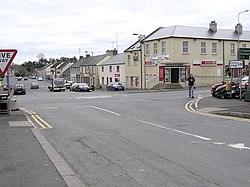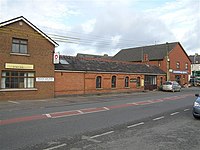Augher: Difference between revisions
Created page with '{{Infobox town |name=Augher |county=Tyrone |picture= |picture caption= |os grid ref=H5653 |LG district=Dungannon }} '''Augher''' is a village in Tyrone. {{stub}}' |
No edit summary |
||
| Line 2: | Line 2: | ||
|name=Augher | |name=Augher | ||
|county=Tyrone | |county=Tyrone | ||
|picture= | |picture=Augher, County Tyrone - geograph.org.uk - 150217.jpg | ||
|picture caption= | |picture caption=Main Street, at A4 junction | ||
|os grid ref= | |os grid ref=H564536 | ||
|LG district= | |latitude=54.428308 | ||
|longitude=-7.1320426 | |||
|population=399 | |||
|census year=2001 | |||
|post town=Augher | |||
|postcode=BT77 | |||
|dialling code=028 | |||
|townland= | |||
|LG district=Mid Ulster | |||
|constituency=Fermanagh and South Tyrone | |||
}} | }} | ||
'''Augher''' is a village in [[Tyrone]]. | '''Augher''' is a small village in southern [[Tyrone]], just six miles from the border of [[County Monaghan]] in the Irish Republic, and is sixteen miles south of [[Dungannon]]. | ||
{{ | The name of the village is from the Gaelic ''Eochair'' meaning "edge" or "border"<ref>{{placenamesNI|8901|Augher}}</ref> It is in the [[Barony of Clogher]].<ref>{{cite web | title=Townlands of County Tyrone| work=IreAtlas Townland Database| url=http://www.thecore.com/seanruad/ | access-date=28 December 2012}}</ref> | ||
The 2001 Census recorded a population of 399. Augher was a victim to several bombings throughout the 1980s and 1990s with 7 bombings in the town, from both the IRA and the UVF. The most recent of these bombings was by the IRA in 1992 against Clogher Valley Creamery, a dominantly Protestant business. | |||
==Historical== | |||
By the time of the Nine Years' War Augher was important enough to be used as a garrison town by the forces of Lord Mountjoy, Elizabeth I's Lord Deputy of Ireland, to disrupt the army of the Earl of Tyrone. | |||
In 1613, after the war and as part of the Plantation of Ulster an area of 315 acres around Augher was given to Sir Thomas Ridgway who had been the Treasurer at War for Ireland. The land grant was strict about what the Undertaker i.e. Ridgway, could do with the land in terms of who had to be settled there and what provisions had to be given to the settlers. Ridgway was successful in developing the town that within two years it awarded a borough charter by James I. | |||
By 1630 the ownership of Augher had passed to Sir James Erskine and during the Irish Rebellion of 1641 the castle was successfully defended against rebel attack. In retaliation the rebels massacred all the English inhabitants in the area. | |||
On the death of Sir James Erskine, Augher Castle and the estate passed into the ownership of the Richardson family who retained the estate well into the 19th century. The castle itself burnt down in 1689, but was restored and extended in 1832. Spur Royal Castle stands to this day. | |||
Under the borough charter, Augher returned two members of parliament to the Irish Parliament, a practice that continued until the abolition of the parliament in 1801 when Ireland and Great Britain were united. This was a 'pocket borough' owned at the time of the Union by John Hamilton, 1st Marquess of Abercorn: when the parliament was abolished, he received £15,000 compensation for the loss of the electoral rights of Augher and Strabane – the other borough he owned.<ref>{{Cite web|url=http://www.proni.gov.uk/introduction_abercorn_d623.pdf|title=Public Record Office of Northern Ireland (PRONI) | nidirect|date=4 March 2016}}</ref> Also abolished at the same time was the civil court established under the charter. | |||
==Transport== | |||
[[File:Augher Railway Station - geograph.org.uk - 1009976.jpg|right|thumb|200px|The old Augher railway station]] | |||
Augher Railway Station was opened on 2 May 1887 by the Clogher Valley Railway and was closed on 1 January 1942.<ref name="AS">{{cite web | title=Augher station | work=Railscot – Irish Railways | url=http://www.railscot.co.uk/Ireland/Irish_railways.pdf | access-date=8 September 2007| archive-url=https://web.archive.org/web/20070926042407/http://www.railscot.co.uk/Ireland/Irish_railways.pdf| archive-date=26 September 2007 |url-status=live}}</ref> The original station building became a coffee shop known as Rosamunde's. After a period of being closed, the now Augher Station House Café came under new ownership, was refurbished and reopened once more.<ref>{{Cite web|last=Mooney|first=Brendan Crossan and Francis|date=2021-03-09|title='Unique and the best trainer I ever seen. RIP Fergal McCann' - Tony Donnelly|url=http://www.irishnews.com/sport/gaafootball/2021/03/09/news/-unique-and-the-best-trainer-i-ever-seen-rip-fergal-mccann---tony-donnelly-2248565/|access-date=2021-07-21|website=The Irish News|language=en}}</ref> | |||
==Sport== | |||
*Football: Augher Stars | |||
*Gaelic sports: Augher St. Macartan's GAC | |||
==Outside links== | |||
{{commons}} | |||
*[http://www.rootsweb.com/~irlkik/ihm/castles/irecastl-Tyrone.htm Spur Royal/Augher Castle – The Castles of Ireland] | |||
==References== | |||
{{reflist}} | |||
Latest revision as of 13:28, 28 November 2022
| Augher | |
| Tyrone | |
|---|---|
 Main Street, at A4 junction | |
| Location | |
| Grid reference: | H564536 |
| Location: | 54°25’42"N, 7°7’55"W |
| Data | |
| Population: | 399 (2001) |
| Post town: | Augher |
| Postcode: | BT77 |
| Dialling code: | 028 |
| Local Government | |
| Council: | Mid-Ulster |
| Parliamentary constituency: |
Fermanagh and South Tyrone |
Augher is a small village in southern Tyrone, just six miles from the border of County Monaghan in the Irish Republic, and is sixteen miles south of Dungannon.
The name of the village is from the Gaelic Eochair meaning "edge" or "border"[1] It is in the Barony of Clogher.[2]
The 2001 Census recorded a population of 399. Augher was a victim to several bombings throughout the 1980s and 1990s with 7 bombings in the town, from both the IRA and the UVF. The most recent of these bombings was by the IRA in 1992 against Clogher Valley Creamery, a dominantly Protestant business.
Historical
By the time of the Nine Years' War Augher was important enough to be used as a garrison town by the forces of Lord Mountjoy, Elizabeth I's Lord Deputy of Ireland, to disrupt the army of the Earl of Tyrone.
In 1613, after the war and as part of the Plantation of Ulster an area of 315 acres around Augher was given to Sir Thomas Ridgway who had been the Treasurer at War for Ireland. The land grant was strict about what the Undertaker i.e. Ridgway, could do with the land in terms of who had to be settled there and what provisions had to be given to the settlers. Ridgway was successful in developing the town that within two years it awarded a borough charter by James I.
By 1630 the ownership of Augher had passed to Sir James Erskine and during the Irish Rebellion of 1641 the castle was successfully defended against rebel attack. In retaliation the rebels massacred all the English inhabitants in the area.
On the death of Sir James Erskine, Augher Castle and the estate passed into the ownership of the Richardson family who retained the estate well into the 19th century. The castle itself burnt down in 1689, but was restored and extended in 1832. Spur Royal Castle stands to this day.
Under the borough charter, Augher returned two members of parliament to the Irish Parliament, a practice that continued until the abolition of the parliament in 1801 when Ireland and Great Britain were united. This was a 'pocket borough' owned at the time of the Union by John Hamilton, 1st Marquess of Abercorn: when the parliament was abolished, he received £15,000 compensation for the loss of the electoral rights of Augher and Strabane – the other borough he owned.[3] Also abolished at the same time was the civil court established under the charter.
Transport

Augher Railway Station was opened on 2 May 1887 by the Clogher Valley Railway and was closed on 1 January 1942.[4] The original station building became a coffee shop known as Rosamunde's. After a period of being closed, the now Augher Station House Café came under new ownership, was refurbished and reopened once more.[5]
Sport
- Football: Augher Stars
- Gaelic sports: Augher St. Macartan's GAC
Outside links
| ("Wikimedia Commons" has material about Augher) |
References
- ↑ Augher - Placenames NI
- ↑ "Townlands of County Tyrone". IreAtlas Townland Database. http://www.thecore.com/seanruad/.
- ↑ "Public Record Office of Northern Ireland (PRONI) | nidirect". 4 March 2016. http://www.proni.gov.uk/introduction_abercorn_d623.pdf.
- ↑ "Augher station". Railscot – Irish Railways. http://www.railscot.co.uk/Ireland/Irish_railways.pdf.
- ↑ Mooney, Brendan Crossan and Francis (2021-03-09). "'Unique and the best trainer I ever seen. RIP Fergal McCann' - Tony Donnelly" (in en). http://www.irishnews.com/sport/gaafootball/2021/03/09/news/-unique-and-the-best-trainer-i-ever-seen-rip-fergal-mccann---tony-donnelly-2248565/.
